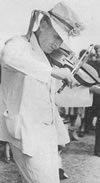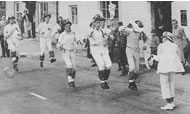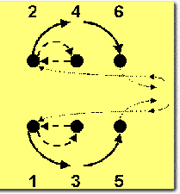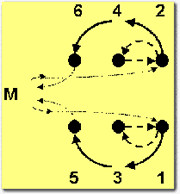Location:
West of Oxford; A40 to Witney and then take A4095
Brief History of Tradition

'Now Mind this let it be said
Our lads all from one village born and bred
Trained and tried they must be
Picked from the best as you see
With legs so straight as a poplar tree
They clap all together and bend the knee'
William 'Jinky' Wells (1868-1953)
The Morris has been danced in Bampton (in-the-Bush) with no break ever having been recorded except during World Wars; it is the only village in England where this can be said with any certainty. The Morris was always danced through the streets and gardens of the village on Whit-Monday (nowadays May Bank Holiday). The dancers were accompanied by a Ragman (carrying clothes, etc.), a Treasurer (collecting Money) and a Sword Bearer carrying a cake that was distributed to the audience; this represented the spirit of the Morris; a posy of flowers was placed on the tip of the sword.

Most of the information gathered by Cecil Sharp between 1908 and 1914 came from Jinky Wells, one time Fool and musician. Bampton is the most fluid of all traditions with many styles (at least 3 heys in common use). A major divergence occurred about 1924, which later resulted in two teams under Francis Shergold and Arnold Woodley. In 1965, a further split of the Woodley Side led to a third side known as 'The Rebels' (under Matt Green).
The Icknield Way Morris Men were instrumental in supporting the Woodley side in the late 70's (through Brian O'Rourke, Paul Smith et. al) and hence our Side adopted the Woodley style of the day. It was introduced to the Icknield Way Morris Men by Old Boy Brian O'Rourke who is currently a member of Bampton.
There are currently more than 33 dances with only one stick dance.
Dances Performed by Our Side
Handkerchief Dances |
Stick Dances |
Jigs |
| Banbury Bill (Corner) Bobbing Around Bonnie Green Garters Flowers of Edinburgh Forester (Side Step) Furzefield Hart's Delight Highland Mary Jenny Lind Johnny so Long at the Fair (Side Step) Just as the Tide was Flowing (Corner) Long Willy Maid o` the Mill Rose Tree (Corner) Step and Fetch Her (aka Shave the Donkey) Shepherd's Hey (6 or 12 man) The Quaker (Side Step) Webbly Leap (Twizzle) Woodley Waltz |
None | Princess Royal Fool's Jig |
Characteristic Features of Tradition (Woodley Style)
| Notation |
Glossary of Terms |
GENERAL |
|
| Style | The style is slightly crouched with a slight swagger on the back-step/hocklebacks. |
| Normal figures | FU/FD, HG, BB and HR. |
| Hand/Arm Movements | Arms are straight up on first beat of bar, and never drop below waist height when dancing |
| Start | All dances have a preparatory hop off the left to the right foot, with hands gathering action |
| Corner Dances |
1st Corner is Number 2. This is the only time dancers ever have the opportunity to rest. |
STEPS |
|
| Stepping | Left foot lead. Mostly single step, with double-step in the side step and hey |
| Side-Step (sso - Open | This is a double-step. Only arm of leading side thrust in the air |
| Forry Capers (FC) | Always off the left foot |
| Plain Capers (PC) | Leap into the air from one foot to the other taking on appearance of backwards cycling. |
FIGURES |
|
| Foot-Up (FU), Foot-Down (FD) | Move up to the music (FU) and then back. Move down from the music (FD) and then back. Turn inwards between FU and FD |
| Half-Gip (HG) | Move well passed partners but maintain straight lines. Pass right shoulders and return same side. Repeat left shoulders. |
| Back-to-Back (BB) | True back to back rather than facing Whole Gip (see Bledington style). Again moving well passed partners, maintaining straight lines. Pass right shoulders, cross over, and returning left shoulders back. Repeat, this time passing left shoulders. |
| Half Rounds (hR) | Dance clockwise to half way position; return and finish with a 'show' (both hands held up). |
| Hey (H) | This is cast with tops moving down the outside, middles following tops and bottoms moving down the inside track
|


